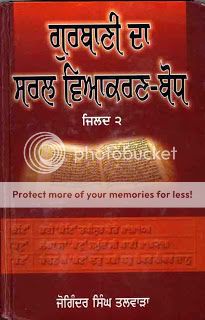- Dec 21, 2010
- 3,387
- 5,690
Serjinder Singh ji I appreciate that you put in specifics and effort in your posts. I read your second post and I am happy to know of your linguistic credentials.
I would love to read your translation of Shabads or other parts as little or as big as possible and compare it with Professor Sahib Singh ji's. It will be instructive. I would not be surprised that you will be coincidental with Professor Sahib Singh ji and will go in similar specific word details as he did. In that context I see little value to all this red-lighting approach even though I am guilty of it too.
The comments here on are in reference to your specific post above,
Professor Sahib Singh ji takes it way beyond this Hindi nonsense as the language of the intellectuals was Sanskrit. He goes into the core Sanskrit words and the origins and meanings thereof if words with such origin are stated in Sanskrit complexity and accent or intonation.
Ask yourself a very simple question. If all you knew was Hindi, do you believe you will understand and be able to read Sri Guru Granth Sahib Ji? Ask your self a simple question, if you were to put Sri Guru Granth Sahib Ji trans-literated (written in Devnagri script) into a Hindi vocabulary and Grammar checker, what would be the percentage of errors detected by such a program?
We need to stop pushing on a string arguments. These will not lead to anything.
In all my readings of parts in SGGS, I have noticed one thing. Guru ji have tried their utmost to refrain from elitist constructs in writing style. Their purpose does not appear to be a writing for few but a writing for many. By design they used language of the people, and of the region, greater Punjab. At that time Hindu writings were in Sanskrit which they avoided like plague as they saw the exploitation of this aspect by the Brahmins.
Sat Sri Akal.
I would love to read your translation of Shabads or other parts as little or as big as possible and compare it with Professor Sahib Singh ji's. It will be instructive. I would not be surprised that you will be coincidental with Professor Sahib Singh ji and will go in similar specific word details as he did. In that context I see little value to all this red-lighting approach even though I am guilty of it too.
The comments here on are in reference to your specific post above,
However, Serjinder Singh ji let us not get into a match of points and counter points. Instead of counting words, is there any difficulty understanding the Shabad with Professor Sahib Singh ji's Darpan, Vyakaran and knowing Punjabi. I have not found any. None depend upon Hindi.
Professor Sahib Singh ji takes it way beyond this Hindi nonsense as the language of the intellectuals was Sanskrit. He goes into the core Sanskrit words and the origins and meanings thereof if words with such origin are stated in Sanskrit complexity and accent or intonation.
Ask yourself a very simple question. If all you knew was Hindi, do you believe you will understand and be able to read Sri Guru Granth Sahib Ji? Ask your self a simple question, if you were to put Sri Guru Granth Sahib Ji trans-literated (written in Devnagri script) into a Hindi vocabulary and Grammar checker, what would be the percentage of errors detected by such a program?
We need to stop pushing on a string arguments. These will not lead to anything.
In all my readings of parts in SGGS, I have noticed one thing. Guru ji have tried their utmost to refrain from elitist constructs in writing style. Their purpose does not appear to be a writing for few but a writing for many. By design they used language of the people, and of the region, greater Punjab. At that time Hindu writings were in Sanskrit which they avoided like plague as they saw the exploitation of this aspect by the Brahmins.
Sat Sri Akal.
Last edited:


